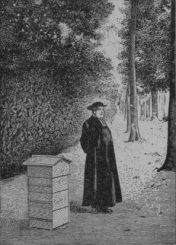
Warré plans
Warré methods
Warré modifications
Warré precursors
Groups / Fora
Google e-group
Biobees.com
forum
Abbé Warré's book
Beekeeping for All:
1.
Warré's spring feeder (page 62, Beekeeping for All)

Bernhard Heuvel's video of this feeder: http://www.youtube.com/watch?v=oHeXfCBpUSo&hl=de
2. Warré's autumn feeder (page 60, Beekeeping for All)
This feeder is made in a standard Warré hive box.
Below: top view of Warré's 'autumn feeder' with the lid removed showing the tank, bee galleries and the removable partition.
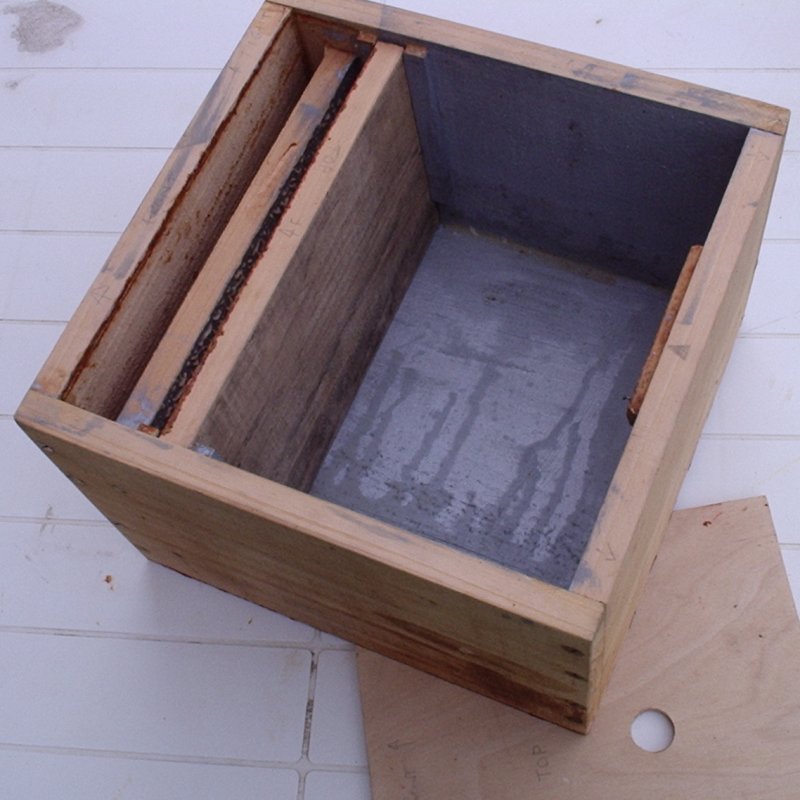
Below: bottom view of Warré's 'autumn feeder' showing access to the bee galleries.
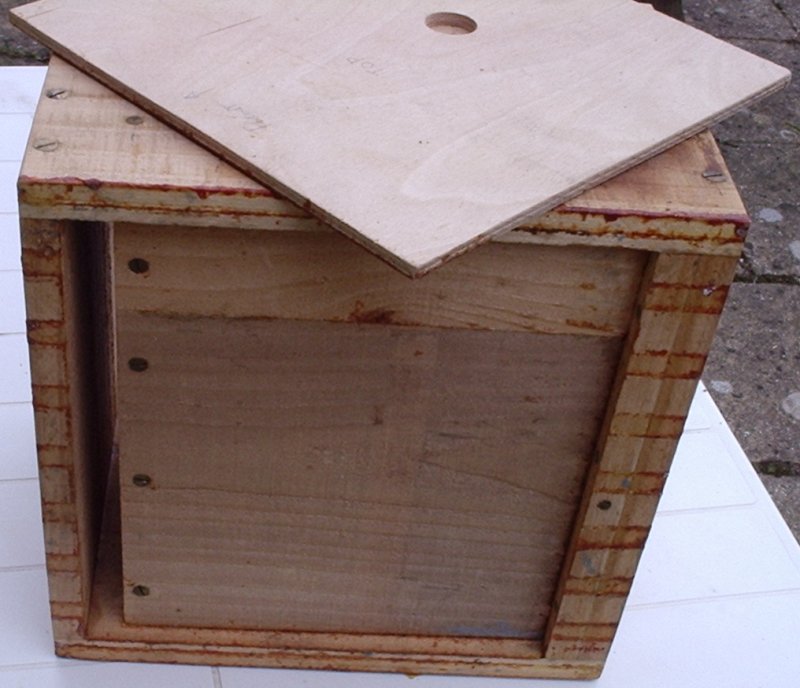
Modified Warré autumn feeder (below)
This is slightly modified from Warré's drawing in that the removable partition is screwed to the fixed partition with two stainless steel screws. Two wooden spacers (shown) hole the movable partition a bee space away from the fixed one and a bee space from the floor of the tank.
Only the bee galleries are covered. This allows refilling the tank without disturbing the bees. The cover is Perspex/Plexiglas held with two screws.
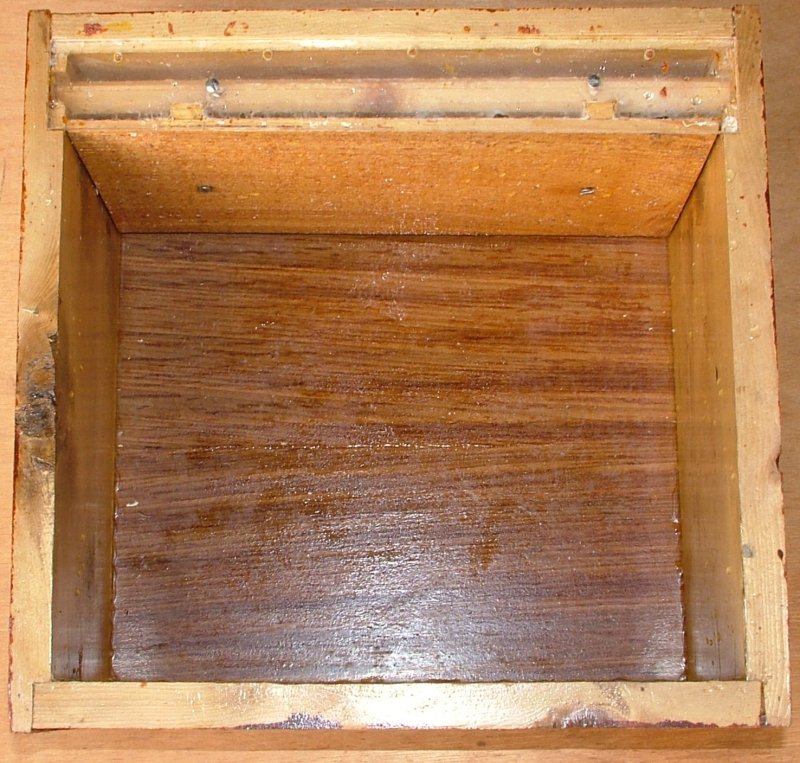
Below: Bottom of autumn feeder showing access from below for the bees into the bee galleries. The floor also sloped towards the feeding area so that almost all feed has gone before bees gain access to the tank. The tank can be sealed with molten wax, but the joints need to be robust. In this example, the floor is set in rebates in the sides. The vertical partition is set in grooves in the walls.
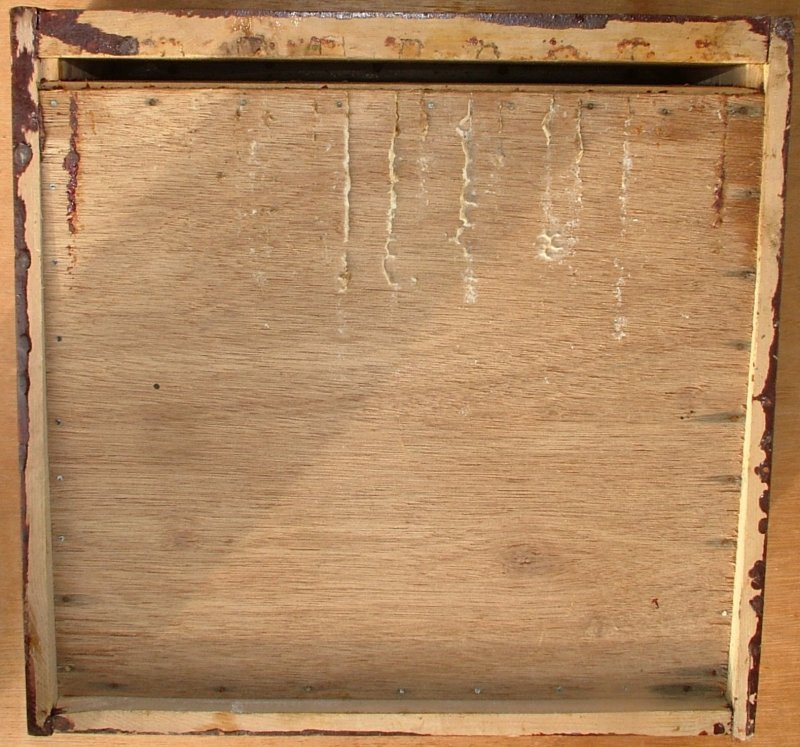
3. (i) Contact feeders: Warré's modified top-bar cloth for a small contact feeder
See page 42 in Beekeeping for All ( http://warre.biobees.com/bfa.htm )
Below: photos of the modified top-bar cloth from Larry Garrett:
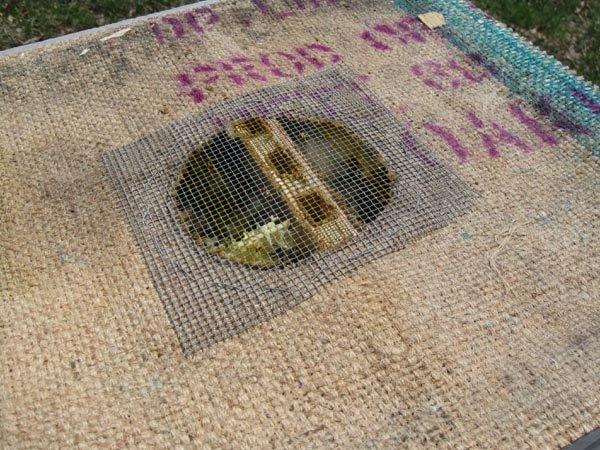
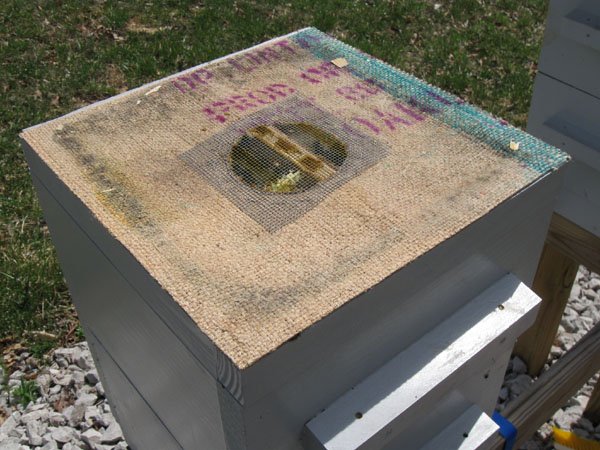
When using this modified top-bar cloth, the lid of the inverted feed container must not be recessed. Otherwise the bees' tongues will not reach the feed. In Warré's application this problem would not arise as the jar is covered with cloth.
3. (ii) Contact feeders: Warrés top-bar cloth for a small contact feeder
Below: assorted contact feeders including a one pound honey jar (300 ml) and a seven pound honey tub (2 litres).
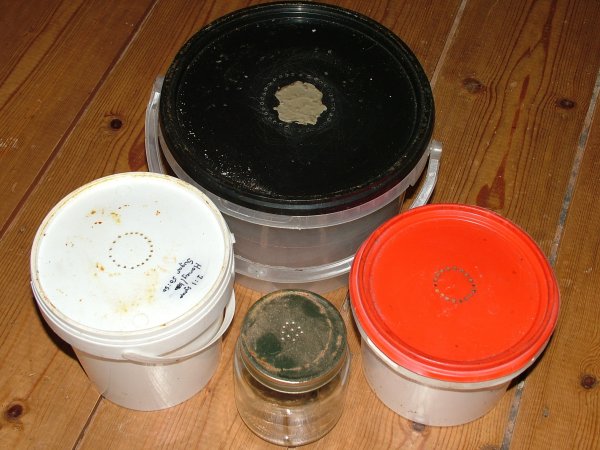
The lids need to be leak-proof round the rims and the hive should be level. When the container is inverted there will be an initial discharge of liquid as the vacuum forms. For the smaller feeders, it does not matter if this drips down into the hive, but for the larger ones, it is preferable to invert the feeder over a suitable container to catch the liquid before placing the feeder inverted on the top-bar cloth. This avoids discharging liquid down to the hive floor which might trigger robbing.
Ideally the containers should be no taller than a quilt box, otherwise the roof will not rest on the quilt box rim and there is a risk that the top-bar cloth will be exposed to rain seepage and wicking.
One may also simply cut a flap in the top-bar cloth to give access to the holes in the container's lid or use a separate top-bar cloth for feeding, with a hole already cut in it to correspond to a gap between top-bars. These feeders may be surrounded with the quilt's insulation which is most conveniently contained in a loosely filled cloth bag.
4. (i) Rapid feeder (large) available from
beekeeping suppliers
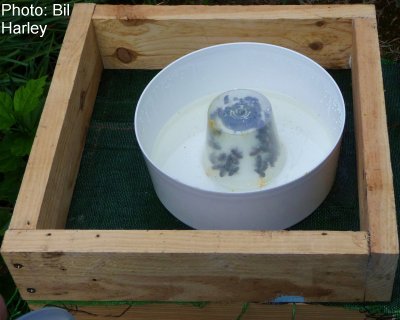
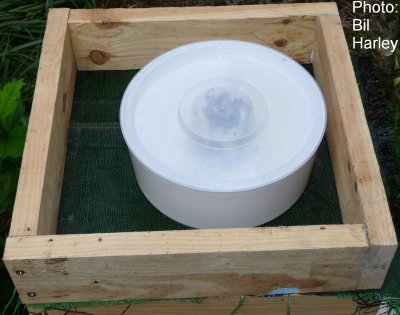
This type generally holds about 2 litres (4 pints), about a quarter the capacity of Warré's autumn feeder (see above). It fits inside a Warré quilt frame. The quilt can be placed on top while the feeder is in place. The bees access the tank through a hole in the top-bar cloth and via a tube in the centre of the feeder. The tank can be refilled with minimal disturbance to the bees, and without them taking wing.
The following version just fits in a Warré quilt frame. It is available at beekeeping supplies worldwide. This UK example was kindly supplied by Beechwood Bees (If out of stock, consider Wynne Jones or Simon the Beekeeper). It is 280 mm diameter by 60 mm high.
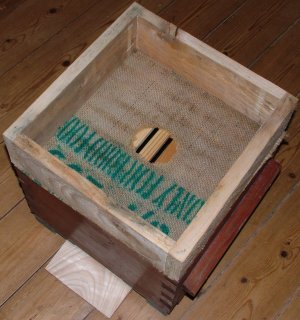
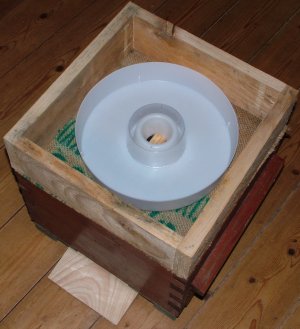
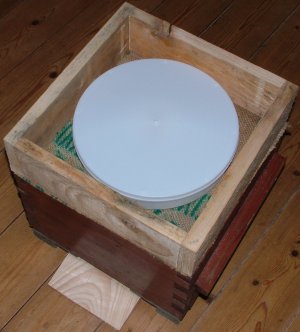
A hole is cut in a top-bar cloth and placed on the top-bars. The feeder is placed with its bee-way over the hole. A transparent plastic cover prevents the bees from taking flight.
This central bee-way and small legs round the rim of the underside of this version raise the feeder slightly off the surface on which it rests. If bees escape through the shallow space created by these projections allows bees to escape, and this is inconvenient, it would be an easy matter to remove them with a file or fine hacksaw. However, with this bee space removed, more care is needed to avoid crushing bees when placing it in the hive.
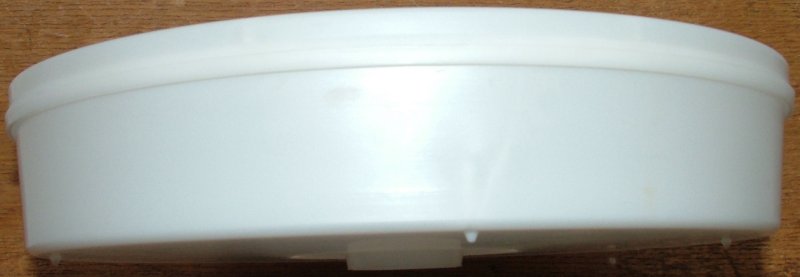
Warning! Some users of this type of feeder have had bees drowning in the space between the central cone and the inverted cup. The reason is that there is sometimes insufficient roughness on the surface of the cone. A simple remedy is to stretch a piece of a child's sock on the surface of the cone as shown in this video: https://www.youtube.com/watch?v=lai1ryV2CrA .
4. (ii) Rapid (small) feeder available from beekeeping supplies
Sold as a 'nuc feeder' e.g. by Thorne (UK). 500 ml capacity, 180 mm (7") diameter, 50 mm (2") deep. The bees access the tank through a hole in the top-bar cloth and via a tube in the centre of the feeder. The tank can be refilled with minimal disturbance to the bees, and without them taking wing.
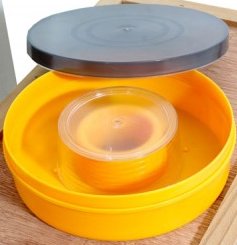
It fits neatly into a Warré quilt box with the quilt's insulation held in a cloth bag and placed above the feeder. To use it, cut a 3-sided flap in the top-bar cloth. Slowly lifting the flap, slide a piece of card underneath it to prevent bees escaping. Then fold back the flap and place the feeder on top of it with the feeder's hole above the flap. Pull out the card to give the bees access to the feeder. To top up the feeder, the black cover is removed and syrup replenished without releasing bees; so no bee protection is required.
John Haverson writes: "I only use it to give a boost to swarms moved to a new location or in poor weather, while they are building comb. I pour in about 300 cc of honey/syrup; this gives bees enough to last overnight but not so much it might discourage them from foraging by day. I top up the feeder two or three times, in the evening, with a total feed of no more than 1000 ml. If the swarms are attracted to a box of used comb [used when hiving them] I tend not to feed. I have used a Demeter recipe of granular cane sugar dissolved in camomile tea (1 lb : 1 pint) with 10% of honey added to the cool syrup. I have noticed that bees consume honey rich syrup much more readily than sugar alone, so I always use at least 50% honey in my honey/syrup feed."
5. Bag feeder
This is another top feeder and has the advantage of being above the cluster, i.e. not only away from robbers but also where the feeding point is kept warm by the bees below. The following is an illustration of Larry Garrett's application of the bag feeder. More details are shown on his page at http://www.warrebeek.com/bagfeeder.html.
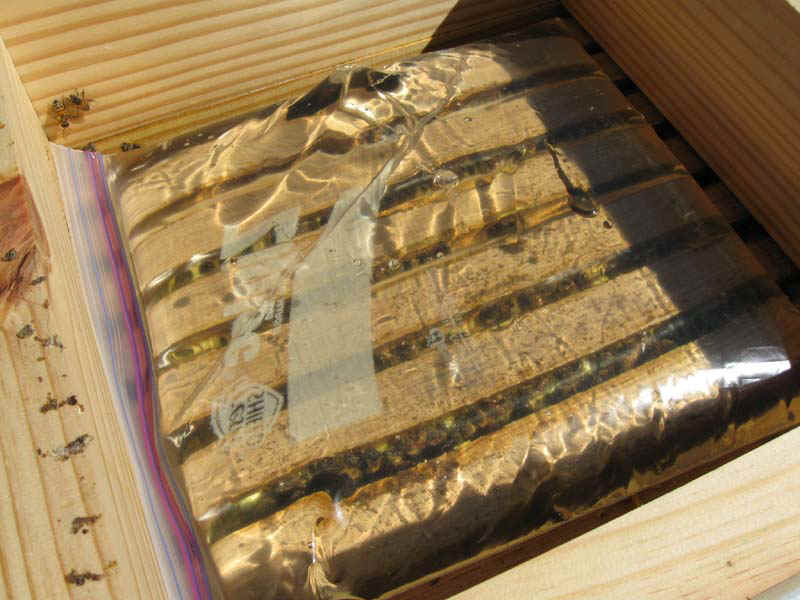
6. Dry sugar feeder
This method has been supplied by Larry Garrett and has been successfully used by him in the Mid-West of the USA over a Warré colony that had managed to occupy only one box by the autumn. It uses baker's sugar that is ultrafine in particle size. This fineness reduces the likelihood of the sugar being carried out of the hive by the bees. It is placed over the colony in much the same way as candy, but unlike candy it has the ability to absorb surplus moisture in the hive.
Below: Dry-sugar feeder with 4lb. (~2kg) sugar placed on newspaper on the top-bars of the top box in an eke or feeding shim. (Photo: Larry Garrett)
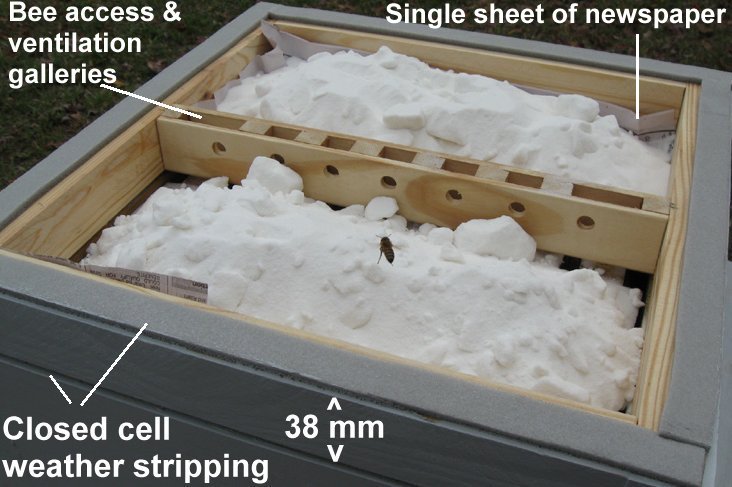
On top of the feeder goes the top-bar cloth, quilt and roof. The ventilation galleries allow moisture to pass to the quilt and to the sugar, which gradually becomes caked. The bees can access the sugar initially via these galleries. Eventually they chew away the newspaper and carry it out of the hive, thus accessing the sugar more directly. In this example, 80% of the sugar was consumed in the course of the winter.
More information: http://www.warrebeek.com/dryfeeder.html
7. Simple floor feeders
Warré's feeders require a certain level of skill in construction, especially in avoiding leaks. The simple feeders illustrated below rest on the floor of the hive in an empty Warré box. Feed placed in such a position is relatively more likely to attract robber bees. Such feeders are therefore to be used with caution, e.g. during a nectar flow, and, if necessary, by installing robber guards that do not significantly impede hive ventilation. Installing or topping up the feed in the evening when scavenger activity is reduced is another worthwhile precaution.
Simple floor feeder (6 litre) with wood float (Bill Wood, Eugene, Oregon)
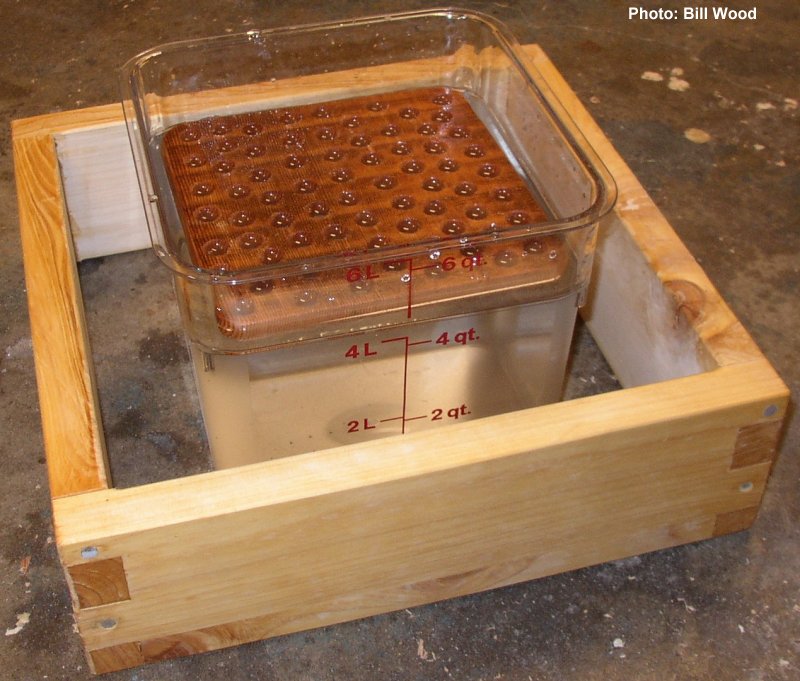
This feeder consists of a perforated raft which safely supports feeding bees and floats down as they consume the (honey + water or Biodynamic mixture or .....) liquid. This floor feeder was made from a 6-litre food grade square plastic tub obtained from a restaurant supply. The bees can safely feed from the edges and from the many holes drilled through the board or "raft". For this "raft", 0.5-inch diameter holes were drilled. For ease of illustration and to indicate relative sizes, the accompanying photograph (above) shows the feeder framed in a standard Warré quilt box. It is a floor feeder capable of holding 4 litres to 6 litres of food.
This feeder should be placed on the floor of a Warré hive in an empty bottom box. It is also suitable for feeding bees in horizontal top-bar and other hives. It is most helpful if the tub has vertical or nearly vertical sides to better maintain a minimal border between the raft sides and the tub sides, from top to bottom. It is important that the raft be able to support numerous engorged bees. Hence, the raft should be made from a low density wood, such as dry cedar and that the thickness of the wood should not be less than ¾ inch or 2 centimetres. Bear in mind that the raft may lose buoyancy if it is not sealed. A natural sealer should be used. A natural varnish or tung oil could be suitable sealers. Bees-wax thinned with d-limonene (a natural citrus solvent) is a moderate liquid water barrier. Natural shellac is another choice, but does not resist long term liquid water.
Both the tub and raft are easy to clean and sterilise. (Bill Wood)
Simple floor feeder using ice cream tubs and straw or twig floats (John Haverson, Hampshire UK)
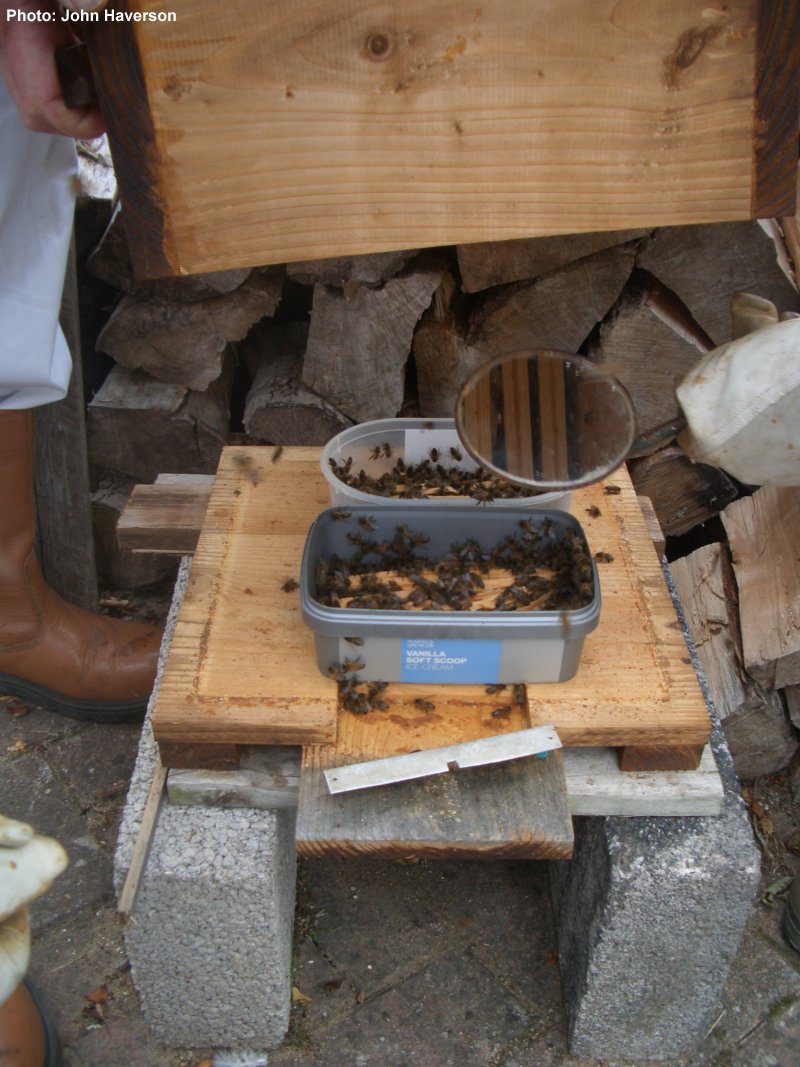
A traditional way of feeding bees is to put the honey or sugar syrup in a suitable container in the hive with the container loosely filled with straw or some other light material such as dry twigs or cork etc. The bees can clamber about on the floating scaffolding without risk of drowning. The above photo shows such feeders made of ice cream tubs placed on a Warré floor. The picture also shows 1) use of a mirror to inspect the inside of the bottom hive box; 2) Warré's L-section entrance piece with the robber-guard that admits one bee at a time in the horizontal plane.
8. Top-feeder with upper entrance and condensation trap
This feeder is used by John Moerschbacher in Alberta, Canada where winter temperatures can be as low as -35C. In such climates it is important to have some way of dealing with the moisture produced by the combustion of sugars in honey, and the approximately 20% water content of the honey, as the winter cluster eats its way upwards into the honey stores. The water vapour is lighter than air and rises. If it meets surfaces at its dew point it will condense. In very cold conditions, it could freeze into a sizeable lump. When spring comes, it could melt and drip on the colony.
This feeder, which is left on all the year round, means a considerable departure from Warré's top-of-hive design. There is no top-bar cloth or Warré-type quilt. Instead, the feeder is placed on the top box as shown in the photo below. The bees can come up through the three holes drilled in the middle partition and feed on candy etc, placed in the feeding troughs either side. Broken combs or scrapings can also be fed here without the danger of provoking robbing. Note that the partition is 1/2" (12 mm) lower than the sides, allowing free movement of the bees inside the feeder.
The holes are 5/8" (16 mm). Bigger is fine. More of them is fine, but the greater the access, the greater the tendency to build comb in the feeder if it is left on all year.
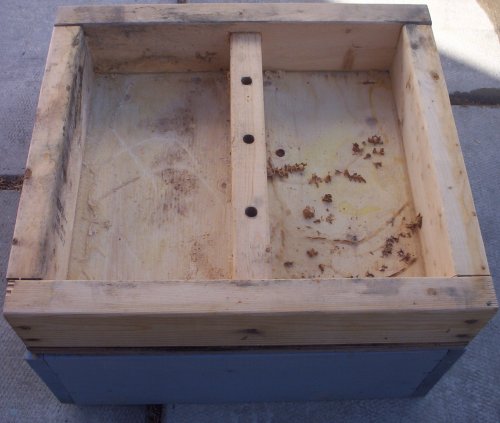
An additional feature of the feeder is the provision in its
lower rim of a small upper or top entrance to the hive (photo below). This can be
especially useful to the colony in the very likely event of the lower or bottom entrance
being blocked by snow. The top entrance on this feeder is about 3/4" (19 mm) long and
1/2" (13 mm) deep.
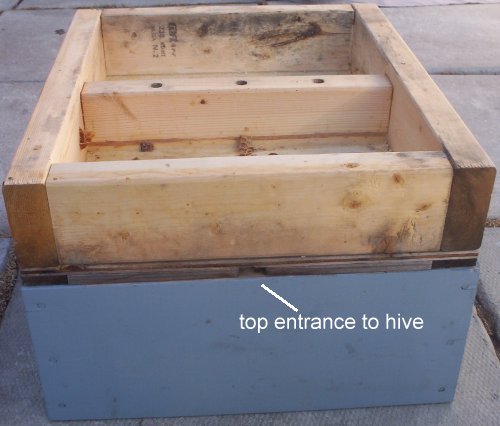
The photo below shows the underside of the feeder, the three holes and the gap left for the hive's upper entrance.
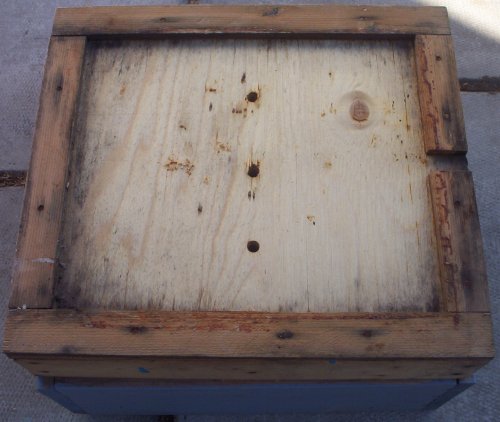
The cross member or partition inside the feeder sits perpendicular to the top bars. In a hive that has adequate insulation, vapour escapes upward through the three access holes and condenses and pools in the feeder troughs. Bees are seen accessing this moisture on winter days when they can break cluster.
On top of this feeder is placed a thin sheet of plywood and a layer of styrofoam/polystyrene. The hive is then wrapped for winter using black building paper. Finally the hive is covered with a full telescoping roof. (A Warré roof would be suitable for this provided that it is clear of the top entrance.) The upper entrance is maintained by cutting a hole in the paper, and tacking a cleat in place. The bees use this entrance almost exclusively in winter. In summer they use both upper and lower entrances.
9. Top feeding of fondant or candy in a Warré hive
A small flap is made in the top-bar cloth. An empty Warré box or quilt frame is placed on the top-bar cloth. The fondant or candy is placed over the hole after holding back the flap. The feed is covered with a plastic tub, followed by a bag of insulation, and then the roof.
The following video is by Bil Harley (Lyon):
10. Jakubov rapid feeder made from any food container with a beeway fitted to the bottom
This feeder is shown on a Warré hive in the photo below. A 5 kg food bucket fits in a standard Warré box.
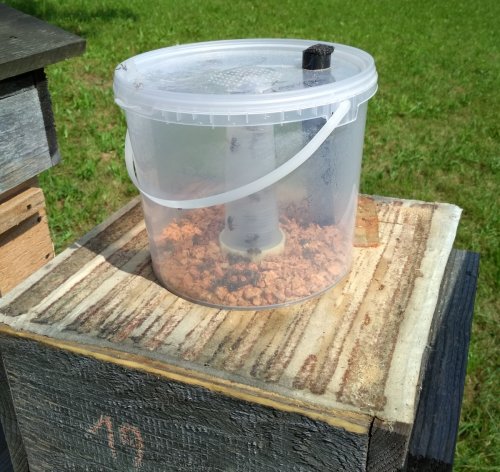
The central beeway and cork granules are obtainable here:
http://objednavky.jakubovske-krmitko.cz/en/objednavka-krmitka/
.
The black tube at the back inserted through the lid allows refilling without disturbing the bees.
Thanks to Andrea for supplying details of this feeder.